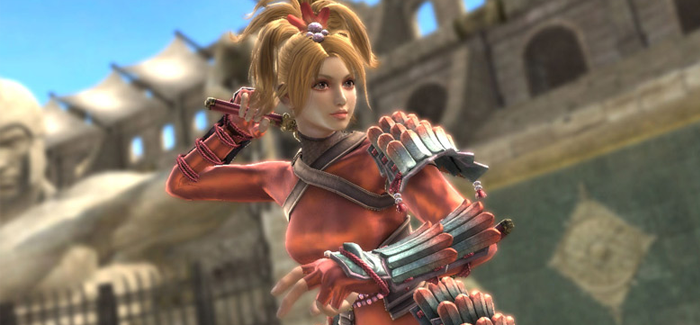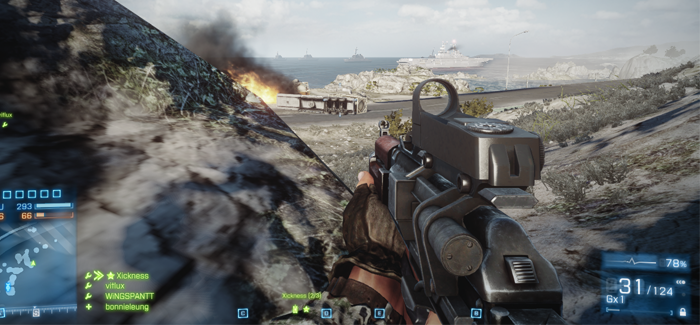


Welcome to Part 6 in WiNGSPANTT’s Assassin’s Creed 4: Black Flag multiplayer strategy guide!
While every aspect of Assassin’s Creed multiplayer requires practice and careful study, nothing baffles new players more than the process of identifying their pursuers. Unlike finding your target, it’s much harder to determine who your own killers are and when they’re about to end your life. Hell, this built-in ambiguity actually contributes greatly to the high-tension tone of every Black Flag match.
But, given enough time, identifying your pursuers becomes second nature. If your would-be murderer plans to take your life, he’ll also have to take risks to approach you, making him identifiable to the well-trained eye. Be vigilant, be sharp, and be ready to stun or run at a moment’s notice.
Just as line of sight is key to offensive ass-kicking, the whispers are vital to your defensive gameplan.
If you don’t know what the whispers are, you probably just haven’t been listening hard enough. Either that, or you’re one of those strange weirdoes who listens to music or something while playing games. Turn off the tunes, turn up your in-game volume, and let your eardrums do their jobs.
The whispers are a creepy, haunting soundtrack that plays whenever a pursuer is close. Just like the heartbeat alerts pursuers of a nearby target, whispers begin playing when your killer is about 10 meters away. You’ll hear vague, echoing sounds that gets louder the closer your pursuer gets. And of course, that soundtrack ends if your pursuer leaves your vicinity… or if your soul leaves your body!
Listening for, recognizing, and reacting to the whispers is important because it’s one of the only direct in-game indications about what your pursuers are doing. When you first hear whispers, you are getting important information about your killers’ locations:
From just those two points alone, you can mentally eliminate a large number of personas as threats and begin looking for other signs that will oust your murderer-to-be. At the very least, you can start calculating the best means of stunning or escaping your enemies.
* Caveat: in Wanted or Deathmatch a neutral player near you may suddenly be assigned as your pursuer.
Aside from the whispers, you won’t get a lot of user interface guidance on your pursuers. Your only real direct indicator will be the pursuer count icon, which takes the form of a skull with a number on it near the middle of your screen.
As you might guess, this indicates the number of people currently gunning (or stabbing) for your head. Normally, you’ll have just one assassin hunting you, but if you’re doing well, the game system will send multiple people to collect your skull for points. On the flip side, the game tends to give you a break if you’re at the bottom of the scoreboard. Turns out life’s fair after all, contrary to what your dad told you.
While your pursuer count won’t directly inform you of who your killers may be or where they’re hiding, it will indirectly notify you of a few things:
All of this information, combined with other guesses and estimates, can help guide your behavior to lower your minute-by-minute risks. For instance, if you have, say, three pursuers and your target is across the map, you’re probably not going to make it to her. Instead, choose a good position to defend from and try to eliminate at least one killer with a stun. By the time that happens, it’s possible another pursuer will end up dead. Now, your odds of taking down your own target are much better with only one jerk tracking you down.
Please note that in Assassinate, your halo radar will give you a good idea of where potential pursuers are, if not exactly who they are. Since halo radar shows the location of every other player, you can guess how many people are waiting to kill you at any given time, and from what direction.
Now, the second you lock onto anyone, you’ll lose your halo radar and gain normal radar, essentially blinding you to additional threats. And even if you stay unlocked, you can be blindsided if any of those players lock you. In that instance, your newly-acquired pursuer will disappear from your halo radar, so it’s important to be just as vigilant about vanishing halo arcs as it is to be mindful of new ones.
This advice overlaps with Identifying Targets: Abilities, so please read up in that section pronto.
Outside of the information earlier in the guide, very little changes between offensive and defensive character identification. Some skills like Bodyguard and Tripwire Bomb are more useful, but otherwise you’ll find most skills will work equally well in either situation.
I would, however, caution against using identification abilities too generously in the defensive position. Most of the time, hiding and running are your best bets for making it out of an altercation alive. Finding out exactly who’s trying to off you if great, but is best done without the use of precious ability slots if you can afford it. Play conservatively and, if need be, dash to the nearest chase breaker.




 So… what games are you thankful for?
So… what games are you thankful for? February ACR Tournament semifinals bracket assignments and bonus footage
February ACR Tournament semifinals bracket assignments and bonus footage Battlefield 3 Review - Multiplayer review for BF3 video game
Battlefield 3 Review - Multiplayer review for BF3 video game AC4 Black Flag multiplayer strategy #18: Abilities Guide (kill streaks)
AC4 Black Flag multiplayer strategy #18: Abilities Guide (kill streaks) AC4 Black Flag multiplayer strategy #16: Abilities Guide (ranged abilities)
AC4 Black Flag multiplayer strategy #16: Abilities Guide (ranged abilities)